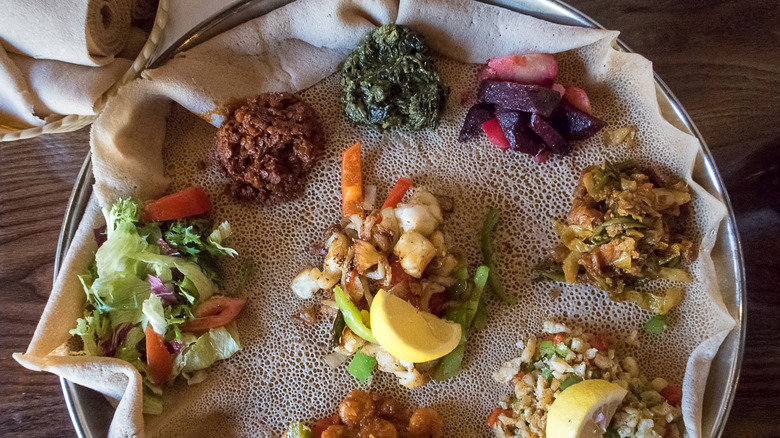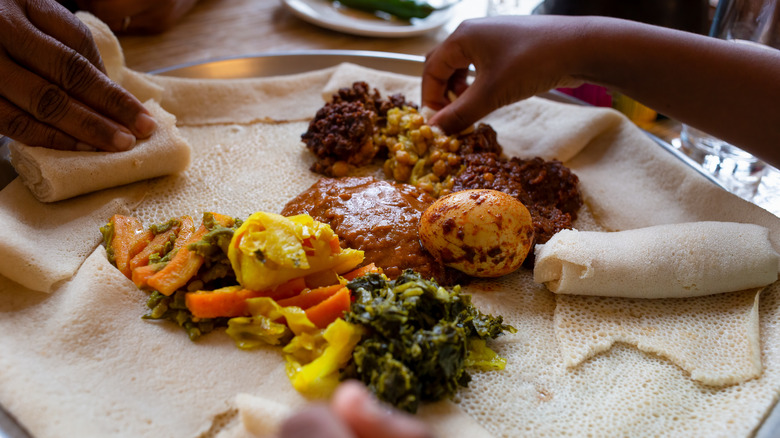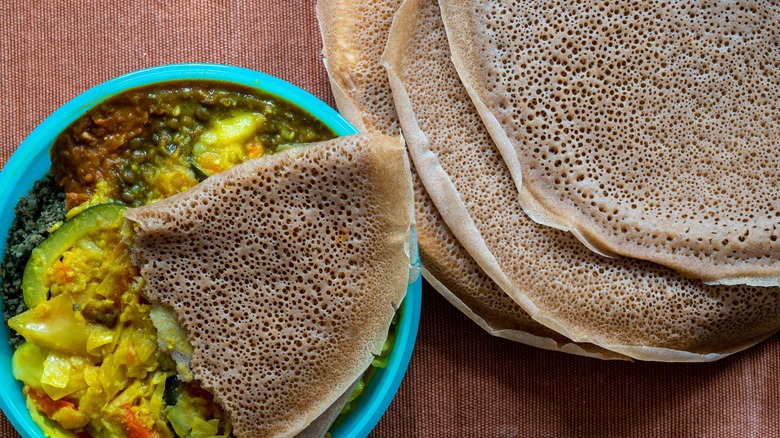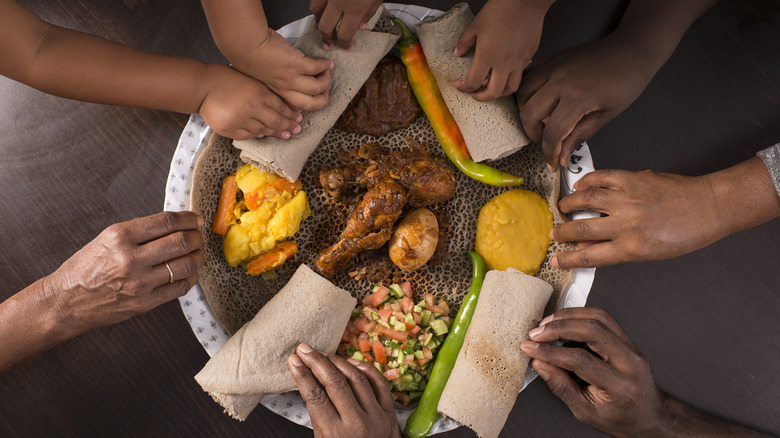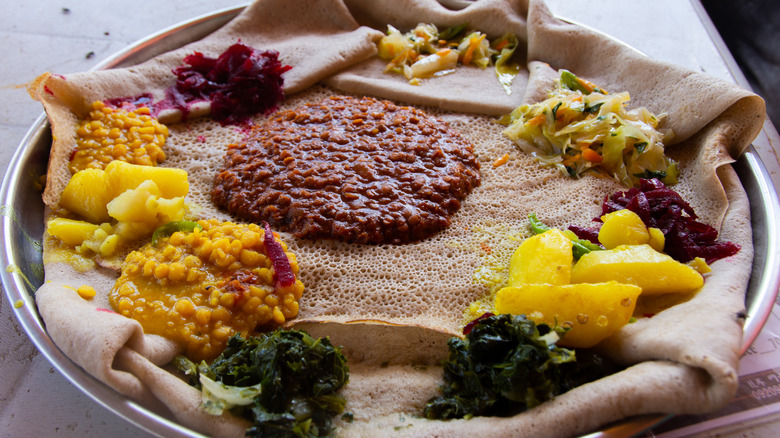10 Mistakes You're Making When Eating At An Ethiopian Restaurant
Ethiopian cuisine is both rich in flavor and history. For centuries, Ethiopians have been growing mixed-grains and accessing spices from countries like India, Portugal, and parts of Asia. As a result, Ethiopians have become masters of flavor — putting together some of the most delectable spice blends like mitmita and berbere. Berbere, an iconic blend made of garlic, ginger, fenugreek, chiles, cloves, and various other spices, is a crowd favorite. It's full of depth, warmth, and complexity that makes your taste buds sing — as Ethiopian food so often does.
With such flavorful dishes and culinary roots, Ethiopian food has made a name for itself in the United States. Its popularity has also increased due to the nature of the cuisine being largely gluten-free with lots of tasty vegetarian options. That said, the excitement around Ethiopian food extends beyond the food itself and into the dining experience as a whole.
When eating at an Ethiopian restaurant, it's important to understand the communal nature of the meal. There are many culinary formalities to unpack and rules around proper dining etiquette to follow. Whether you're a repeat customer or trying the cuisine for the first time, the lack of utensils, communal plates, and tradition of feeding others may be tricky to navigate. Luckily, we've laid out the top mistakes you should avoid.
Coming into the restaurant with a closed mind
If it's your first time trying Ethiopian food, it's critical to come into the restaurant with an open mind. We have no doubt you'll be blown away by the exquisite depth of flavor in Ethiopian stews and salads, but the dining experience may be completely new to you. From the way the food is served to the way it's eaten, the structure is totally unique, and it provides for an exciting meal if you keep your mind open.
Ethiopian cuisine is really just as much about the dining experience as it is about the food. There's an emphasis on community and shared experience, as everyone sits shoulder-to-shoulder around the same table — eating off a singular large platter. It's also about using all your senses besides just taste, with smell and touch being particularly significant. After all, eating Ethiopian food is a hands-on experience, literally. There are no utensils, and bread becomes the ultimate food scooper.
At the end of the day, Ethiopian food is meant to be enjoyed by not only your gut but by your brain and soul as well. The food becomes a window into the country's culinary roots and all-around cultural values. So why not embrace all of it with an open mind, and start off by trying a dish that's regarded as Ethiopia's national dish — Doro Wat. The spicy, flavor-packed stew is truly incredible.
Asking for plates or silverware
Ethiopian food is typically eaten with injera — a type of flatbread made of native, popular grains. Traditionally, it's prepared solely with teff flour, but due to the high cost of teff in the U.S., wheat flour is often added to the batter. So, if you're gluten-free, make sure to check the ingredients with the host or chef.
Calling injera a flatbread doesn't do the staple Ethiopian food justice. Injera is the base of nearly all Ethiopian meals. It looks more like a very large crepe with the slight lift and sponginess of a pancake. The taste, on the other hand, is in a league of its own. Injera has a tanginess that resembles an ancient grain sourdough. This is because it's fermented first, with the flour, water, and starter doing their thing over the course of about a couple of days. Once it's ready, the batter gets ladled onto a large, round griddle called a mitad to be cooked.
At this point, the warm, delicious injera is brought out to your table along with your meal. There's really no need to ask for silverware since the injera takes its place. Besides the fact that there's a good chance the restaurant doesn't even have utensils, it may even appear offensive if you do. You're expected to eat with your hands, using the injera to scoop up your food. It's quite a wonderful way to eat. Try this shortcut injera recipe at home and see for yourself.
Forgetting to wash your hands
Hand washing before meals is a tradition that spans across many countries and religions around the world. Its main purpose is to ensure cleanliness and safeguard health, but it also serves as a sign of respect. Hand washing demonstrates a readiness to accept something that took time and effort to prepare — so it's a great practice in general.
Since Ethiopian food is shared and everyone eats with their hands, it's customary as well as sanitary to wash your hands before and after a meal. The last thing you want to do is spread germs or offend those who prepared and served your food. If you're a guest at an Ethiopian dinner, sometimes the host will bring you a pitcher of warm water and a basin to wash your hands in. In this instance, it's customary to place your hand in the basin and then wait for the host to pour the water over them. When it comes to eating out at an Ethiopian restaurant, this may or may not happen. If not, the best course of action is to wash your hands properly with soap and water in the bathroom. You always want to ensure cleanliness, sanitation, and respect for cultural traditions when eating out.
Using both hands to handle your food
When the delicious platter of Ethiopian dishes finally arrives at your table, make sure to use your right hand when handling the injera and scooping up your food. In Ethiopian culture, the left hand is considered unclean, and using it to eat is often seen as rude and improper. So, while using your right hand for everything dining related, make sure to keep your left hand off the table. Good table manners are a sign of respect for both the food on your plate, those who prepared it, and the nation's culinary traditions.
It's important to note that this custom is not as heavily enforced in the U.S., and if you're left handed, you'll likely be grateful for the laxity in standards. Nevertheless, it's the most proper and traditional way of eating Ethiopian food and one of the many food rules across different cuisines that get lost in translation.
Besides being respectful, when everyone eats with their right hand around a shared plate, it provides a certain order and organization that limits elbow bumping. In a communal setting, your neighbor will likely thank you for the unperturbed dining experience.
Wrapping as opposed to tearing your injera
Unlike Italian food, where bread is served as a side dish for dipping, or Mexican food where it's used to wrap all your food in, injera is meant to be torn into pieces. Since it takes the place of your silverware, ensure the piece you tear isn't too large. You want to be able to grab enough bite-sized food but not so much that you have to force a mouthful. Once you've grabbed your food, go ahead and squeeze the edges so no food falls out of your injera on the way to your mouth. The idea is to avoid clumsiness and push it delicately into your mouth without stuffing or touching your fingers to your lips. This ensures both proper etiquette and cleanliness since everyone is going back in for seconds, thirds, and more.
Take notice that injera comes both wrapped up on the side of your meal as well as underneath the large, communal plate your dishes are served on. In a way, the latter injera is used as a plate on top of your plate. Once everyone at the table has eaten the majority of the dishes served, it may be tempting to wrap the remainder of the food up like a burrito, but it's best to continue tearing the injera at the bottom of the plate in the same way.
Reaching across the communal table
The best way to keep dinner orderly when eating Ethiopian food is to first eat the food that's closest to you. This is the customary way to do it, and luckily the plate is often set up so there's a little bit of each dish on each side. This makes it easy to access the food closest to you without missing out on any of the flavorful dishes.
Still, there may be times when the main dish is farther from you, and the only way to get it would be to reach across the table. Avoid reaching abruptly across the table, though, as it's considered rude in Ethiopian culture. Instead, be watchful and try to follow the rhythm of the guests in your party. The most polite option is to wait until most other people have removed their hands from over the plate and then take your turn. If the plate spins, spin it around so that the dish you were looking for is now closer to you — then go for it. Whichever way you're able to do it, the key is to take turns when reaching to scoop food off the communal plate. There are a lot of delicious dishes in Ethiopian cuisine, and everyone deserves a taste. For some ordering inspiration, here are some iconic Ethiopian foods to try next time you're at an Ethiopian restaurant. We know they won't disappoint!
Forgetting to let the eldest in your party eat first
In many cultures, a part of proper dining etiquette is to let the eldest guest sitting at the table have the first bite. It's a sign of respect and honor for the person, their kinship, and the culture as a whole. When sitting down for an Ethiopian meal, this tradition is no different. The eldest of the bunch kicks off the eating, and then everyone else can join in. If you want to go above and beyond, pay attention to the pace and patterns set by the group's oldest member. Not eating too much faster than the eldest is a gesture of compassion. The meal is shared, after all, and everyone should be full and satisfied by the end of it.
If you want to make sure that everyone's bellies are content by the end of a meal, try preparing or seeking out an Ethiopian breakfast. There are a few super-filling dishes that everyone will enjoy — from older guests to younger ones. One popular breakfast dish is Genfo, a porridge made of dry roasted barley flour. Another great option is Fit-Fit, a mix of berbere spices and injera or kitcha (a different type of flatbread) that many folks find tasty and comforting.
Thinking feeding others is taboo
When it comes to Ethiopian dining, it's not uncommon for someone else to feed you. In fact, there's a name for this practice — gursha. "Gursha" comes from the Amharic word for "mouthful" and is performed as a gesture of affection and sign of respect. It's polite to accept and also reciprocate the offering as a way to display the strong bond you have with that person. Given you're usually dining with people close to you, like friends and family, this can be quite an endearing and fun experience.
When deciding to feed someone else, use the same technique you use for yourself. Scoop up some delicious curry and protein, and then gently place it in your neighbor's mouth. Do your best not to touch their face — being dainty is key here. If you know the person sitting next to you is an adventurous eater and enjoys raw proteins like sushi or steak tartare, feed them a dish called dulet. Dulet is a traditional dish made with minced beef, liver, and tripe. It's mixed with vegetables like onions, peppers, and various species — packed full of unique taste and texture that can be very enjoyable.
Licking your fingers while eating
Licking your fingers while eating is one of many dining etiquette mistakes that many cultures share. Even though you eat Ethiopian food with your hands, this rule still applies. The difference is that it can be a lot more tempting to lick your fingers when you're digging into things free of silverware. Nevertheless, it's still very much frowned upon, not to mention particularly unsanitary given the communal nature of the meal. You don't want to spread germs unnecessarily or get anyone else sick — so keep those fingers out of your mouth.
There's no doubt you will, at times, scoop up your food with the injera incorrectly. Food on your fingers is pretty inevitable, and you may get an urge to clean it off one way or another. Instead of licking your fingers or heading to the bathroom to wash your hands multiple times, use the next piece of injera you tear off to discreetly wipe your fingers on. A little tip like this will go a long way when it comes to Ethiopian dining.
Not mixing your dishes together
Although it may not come naturally, mixing and matching Ethiopian dishes is customary. Since everything is laid out next to each other on the communal plate, it's easy to accomplish. If you've never had Ethiopian food, start by just tasting each dish individually. Then experiment with a few different combos. One idea is to make sure you have a variety of textures in one bite. Perhaps scoop up some vegetables, stew, and your protein of choice into one piece of injera. You can also mix spicier dishes like Doro Wat with more mild salad options for a nice balance of heat. This process of mixing and matching is part of the magic of Ethiopian dining, so have fun with it.
One ingredient that makes many Ethiopian dishes so tasty and easily mixable is niter kibbeh. This is a spiced clarified butter made with garlic, caraway, ginger, turmeric, black cardamom, and koseret (an oregano-like spice). Kitfo is a popular dish made with this unique, clarified butter that's enjoyed by many. In this dish, niter kibbeh is added to minced raw beef and then mixed with a spice blend called mitmita. The blend adds some heat from its chiles and warmer flavors from spices like cardamom and cumin. Like many Ethiopian dishes, the result is delectable!
